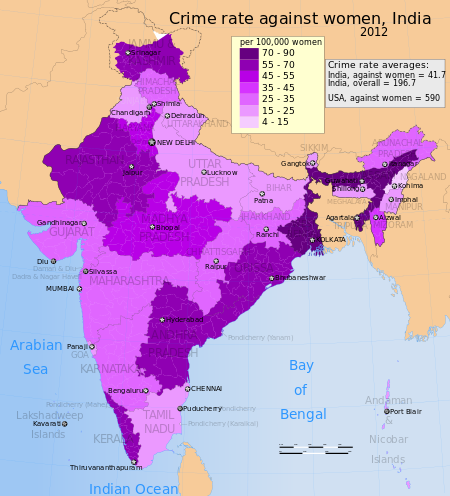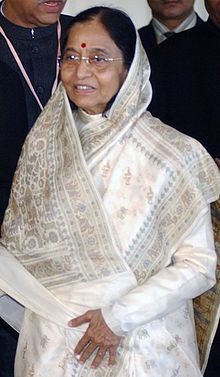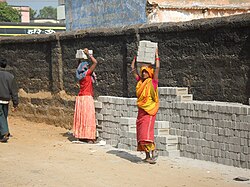| Women in society |
|---|
 |
|
|
|
|
|
|
|
|
|
|
|
|
|
|
|
|
History
Ancient India
According to scholars, women in ancient India enjoyed
equal status with men in all aspects of life.
[9] Works by ancient Indian grammarians such as
Patanjali and
Katyayana suggest that women were educated in the early
Vedic period.
[10][11] Rigvedic verses suggest that women married at a mature age and were probably free to select their own husbands.
[12] Scriptures such as the
Rig Veda and
Upanishads mention several women sages and seers, notably
Gargiand
Maitreyi.
[13]
There are very few texts specifically dealing with the role of women
[14] an important exception is the
Stri Dharma Paddhati of Tryambakayajvan, an official at
Thanjavur c. 1730. The text compiles strictures on women's behaviour dating back to the
Apastamba sutra (c. 4th century BCE).
[15] The opening verse goes:
- mukhyo dharmaH smr^tiShu vihito bhartr^shushruShANam hi :
- women are enjoined to be of service to their husbands.
Some kingdoms in ancient India had traditions such as
nagarvadhu ("bride of the city"). Women competed to win the coveted title of
nagarvadhu.
Amrapali is the most famous example of a nagarvadhu.
According to studies, women enjoyed equal status and rights during the early
Vedic period.
[16] However in approximately 500 B.C., the status of women began to decline, and with the
Islamic invasion of
Babur and the
Mughal empire and Christianity later worsened women's freedom and rights.
[5]
Although reform movements such as
Jainism allowed women to be admitted to religious orders, by and large women in India faced confinement and restrictions.
[16] The practice of
child marriages is believed to have started around the sixth century.
[17]
Medieval period
Indian women's position in society further deteriorated during the medieval period,
[5][9] when
child marriages and a ban on remarriage by widows became part of social life in some communities in India. The
Muslim conquest in the Indian subcontinent brought
purdah to Indian society. Among the
Rajputs of Rajasthan, the
Jauhar was practised. In some parts of India, some of
Devadasis were sexually exploited. Polygamy was practised among
Hindu Kshatriya rulers for some political reasons.
[17] In many Muslim families, women were restricted to
Zenana areas of the house.
In spite of these conditions, women often became prominent in the fields of politics, literature, education and religion.
[5]Razia Sultana became the only woman monarch to have ever ruled
Delhi. The
Gond queen
Durgavati ruled for fifteen years before losing her life in a battle with Mughal emperor
Akbar's general Asaf Khan in 1564.
Chand Bibi defended
Ahmednagar against the powerful
Mughal forces of Akbar in the 1590s.
Jehangir's wife
Nur Jehan effectively wielded imperial power, and was recognized as the real power behind the Mughal throne. The Mughal princesses Jahanara and Zebunnissa were well-known poets, and also influenced the ruling powers.
Shivaji's mother,
Jijabai, was queen regent because of her ability as a warrior and an administrator. In South India, many women administered villages, towns, and divisions, and ushered in new social and religious institutions.
[17]
The
Bhakti movements tried to restore women's status and questioned certain forms of oppression.
[16] Mirabai, a female saint-poet, was one of the most important Bhakti movement figures. Other female saint-poets from this period included
Akka Mahadevi, Rami Janabai and
Lal Ded. Bhakti sects within Hinduism such as the Mahanubhav, Varkari and many others were principle movements within the Hindu fold openly advocating social justice and equality between men and women.
Immediately following the Bhakti movements,
Guru Nanak, the first Guru of
Sikhs, preached equality between men and women. He advocated that women be allowed to lead religious assemblies; to lead congregational hymn singing called
Kirtan or
Bhajan; to become members of religious management committees; to lead armies on the battlefield; to have equality in marriage, and to have equality in
Amrit (Baptism). Other
Sikh Gurus also preached the same, but their practices were often regarded to be a breach of women rights.
Historical practices
Traditions such as Sati, Jauhar, and Devadasi among some communities have been banned and are largely defunct in modern India. However, some instances of these practices are still found in remote parts of India. The purdah is still practiced by Indian women in some communities. Child marriage remains common in rural areas, although it is illegal under current Indian law.
- Sati
- Sati is an old, almost completely defunct custom among some communities, in which the widow was immolated alive on her husband's funeral pyre. Although the act was supposed to be voluntary on the widow's part, its practice is forbidden by the Hindu scriptures in Kali yuga, the current age.[18] After the foreign invasions of Indian subcontinent, this practice started to mark its presence, as women were often raped or kidnapped by the foreign forces.[19] It was abolished by the British in 1829. There have been around forty reported cases of sati since independence.[20] In 1987, the Roop Kanwar case in Rajasthan led to The Commission of Sati (Prevention) Act.[21]
- Jauhar
- Jauhar refers to the practice of voluntary immolation by wives and daughters of defeated warriors, in order to avoid capture and consequent molestation by the enemy. The practice was followed by the wives of defeated Rajput rulers, who are known to place a high premium on honour. Evidently such practice took place during the Islamic invasions of India.[22]
- Purdah
- Purdah is the practice among some Muslim communities requiring women to cover themselves so as to conceal their faces and form from males. It imposes restrictions on the mobility of women, curtails their right to interact freely.[citation needed]
- Devadasis
- Devadasi is often misunderstood as religious practice. It was practised in southern India, in which women were "married" to a deity or temple. The ritual was well-established by the 10th century A.D.[23] By 1988, the practice was outlawed in the country.[24]
British rule
European scholars observed in the 19th century that Hindu women are "naturally chaste" and "more virtuous" than other women.
[25] During the
British Raj, many reformers such as
Ram Mohan Roy,
Ishwar Chandra Vidyasagar and
Jyotirao Phule fought for the betterment of women.
Peary Charan Sarkar, a former student of Hindu College, Calcutta and a member of "Young Bengal", set up the first free school for girls in India in 1847 in Barasat, a suburb of Calcutta (later the school was named Kalikrishna Girls' High School).
While this might suggest that there was no positive British contribution during the Raj era, that is not entirely the case. Missionaries' wives such as Martha Mault née Mead and her daughter Eliza Caldwell née Mault are rightly remembered for pioneering the education and training of girls in south India. This practice was initially met with local resistance, as it flew in the face of tradition. Raja Rammohan Roy's efforts led to the abolition of Sati under
Governor-General William Cavendish-Bentinck in 1829. Ishwar Chandra Vidyasagar's crusade for improvement in the situation of widows led to the
Widow Remarriage Act of 1856. Many women reformers such as
Pandita Ramabai also helped the cause of women.
In 1917, the first women's delegation met the Secretary of State to demand women's political rights, supported by the Indian National Congress. The All India Women's Education Conference was held in Pune in 1927, it became a major organisation in the movement for social change.
[16][27] In 1929, the Child Marriage Restraint Act was passed, stipulating fourteen as the minimum age of marriage for a girl.
[16][28][full citation needed] Though
Mahatma Gandhi himself married at the age of thirteen, he later urged people to boycott child marriages and called upon young men to marry child widows.
[29]
Independent India

Female Safety Index per state according to the Tata Strategic Management Group. Light green indicates greatest safety; yellow, medium safety and light red, least safety.
Women in India now participate fully in areas such as education, sports, politics, media, art and culture, service sectors, science and technology, etc.
[5] Indira Gandhi, who served as
Prime Minister of India for an aggregate period of fifteen years, is the world's longest serving woman Prime Minister.
[30]
The Constitution of India guarantees to all Indian women equality (Article 14), no discrimination by the State (Article 15(1)), equality of opportunity (Article 16), and equal pay for equal work (Article 39(d)). In addition, it allows special provisions to be made by the State in favour of women and children (Article 15(3)), renounces practices derogatory to the dignity of women (Article 51(A) (e)), and also allows for provisions to be made by the State for securing just and humane conditions of work and for maternity relief. (Article 42).
[31]
Feminist activism in India gained momentum in the late 1970s. One of the first national-level issues that brought women's groups together was the
Mathura rape case. The acquittal of policemen accused of raping a young girl Mathura in a police station led to country-wide protests in 1979-1980. The protests, widely covered by the national media, forced the Government to amend the Evidence Act, the Criminal Procedure Code, and the Indian Penal Code; and created a new offence, custodial rape.
[31] Female activists also united over issues such as female infanticide, gender bias, women's health, women's safety, and women's literacy.
In 1990s, grants from foreign donor agencies enabled the formation of new women-oriented NGOs. Self-help groups and NGOs such as
Self Employed Women's Association (SEWA) have played a major role in the advancement of women's rights in India. Many women have emerged as leaders of local movements; for example,
Medha Patkar of the
Narmada Bachao Andolan.
The Government of India declared 2001 as the Year of Women's Empowerment (
Swashakti).
[16] The National Policy For The Empowerment Of Women came was passed in 2001.
[33]
In 2006, the case of
Imrana, a Muslim rape victim, was highlighted by the media. Imrana was raped by her father-in-law. The pronouncement of some Muslim clerics that Imrana should marry her father-in-law led to widespread protests, and finally Imrana's father-in-law was sentenced to 10 years in prison. The verdict was welcomed by many women's groups and the All India Muslim Personal Law Board.
[34]
According to a report by
Thomson Reuters, India is the "fourth most dangerous country" in the world for women,
[35][36] India was also noted as the worst country for women among the
G20 countries,
[37] however, this report has faced criticism for its inaccuracy.
[38] In 9 March 2010, one day after International Women's day, Rajya Sabha passed the Women's Reservation Bill requiring that 33% of seats in India's Parliament and state legislative bodies be reserved for women.
[39]
Timeline
The steady change in the position of women can be highlighted by looking at what has been achieved by women in the country:
- 1848: Savitribai Phule, along with her husband Jyotirao Phule, opened a school for girls in Pune, India. Savitribai Phule became the first woman teacher in India.
- 1879: John Elliot Drinkwater Bethune established the Bethune School in 1849, which developed into the Bethune College in 1879, thus becoming the first women's college in India.
- 1883: Chandramukhi Basu and Kadambini Ganguly became the first female graduates of India and the British Empire.
- 1886: Kadambini Ganguly and Anandi Gopal Joshi became the first women from India to be trained in Western medicine.
- 1898: Sister Nivedita Girls' School was inaugurated
- 1905: Suzanne RD Tata becomes the first Indian woman to drive a car.[40]
- 1916: The first women's university, SNDT Women's University, was founded on 2 June 1916 by the social reformer Dhondo Keshav Karve with just five students.
- 1917: Annie Besant became the first female president of the Indian National Congress.
- 1919: For her distinguished social service, Pandita Ramabai became the first Indian woman to be awarded the Kaisar-i-Hind Medal by the British Raj.
- 1925: Sarojini Naidu became the first Indian born female president of the Indian National Congress.
- 1927: The All India Women's Conference was founded.
- 1944: Asima Chatterjee became the first Indian woman to be conferred the Doctorate of Science by an Indian university.
- 1947: On 15 August 1947, following independence, Sarojini Naidu became the governor of the United Provinces, and in the process became India's first woman governor.
- 1951: Prem Mathur of the Deccan Airways becomes the first Indian woman commercial pilot.
- 1953: Vijaya Lakshmi Pandit became the first woman (and first Indian) president of the United Nations General Assembly
- 1954: Ramakrishna Sarada Mission was formed for women monks.
- 1959: Anna Chandy becomes the first Indian woman judge of a High Court (Kerala High Court)[41]
- 1963: Sucheta Kriplani became the Chief Minister of Uttar Pradesh, the first woman to hold that position in any Indian state.
- 1966: Captain Durga Banerjee becomes the first Indian woman pilot of the state airline, Indian Airlines.
- 1966: Kamaladevi Chattopadhyay wins Ramon Magsaysay award for community leadership.
- 1966: Indira Gandhi becomes the first woman Prime Minister of India
- 1970: Kamaljit Sandhu becomes the first Indian woman to win a Gold in the Asian Games
- 1972: Kiran Bedi becomes the first female recruit to join the Indian Police Service.[42]
- 1979: Mother Teresa wins the Nobel Peace Prize, becoming the first Indian female citizen to do so.
- 1984: On 23 May, Bachendri Pal became the first Indian woman to climb Mount Everest.
- 1986 : Surekha Yadav became the first woman loco-pilot, railway driver, for India and Asia.
- 1989: Justice M. Fathima Beevi becomes the first woman judge of the Supreme Court of India.[43]
- 1992: Priya Jhingan becomes the first lady cadet to join the Indian Army (later commissioned on 6 March 1993)[44]
Culture
A
sari (a long piece of fabric wound around the body) and
salwar kameez are worn by women all over India. A
bindi is part of a woman's make-up. Despite common belief, the bindi on the forehead does not signify marital status; however, the
Sindoor does.
[45]
Rangoli (or Kolam) is a traditional art very popular among Indian women.
Education and economic development
According to 1992-93 figures, only 9.2% of the households in India were headed by females. However, approximately 35% of the households below the poverty line were found to be headed by females.
[46]
Education
Though it is gradually increasing, the female literacy rate in India is less than the male literacy rate.
[47] Far fewer girls than boys are enrolled in school, and many girls drop out.
[31] In urban India, girls are nearly on a par with boys in terms of education. However, in rural India girls continue to be less well-educated than boys. According to the National Sample Survey Data of 1997, only the states of
Kerala and
Mizoram have approached universal female literacy. According to scholars, the major factor behind improvements in the social and economic status of women in Kerala is literacy.
[31]
Under the Non-Formal Education programme (NFE), about 40% of the NFE centres in states and 10% of the centres in
UTs are exclusively
reserved for females. As of 2000, about 300,000 NFE centres were catering to about 7.42 million children. About 120,000 NFE centres were exclusively for girls.
[48]
According to a 1998 report by the U.S. Department of Commerce, the chief barriers to
female education in India are inadequate school facilities (such as sanitary facilities), shortage of female teachers and gender bias in the curriculum (female characters being depicted as weak and helpless).
[49]
Workforce participation
Contrary to common perception, a large percentage of women in India work.
[50] National data collection agencies accept that statistics seriously understate women's contribution as workers.
[31] However, there are far fewer women than men in the paid workforce. In urban India, women participate in the workforce in impressive numbers. For example, in the software industry 30% of the workforce is female.
[51] In the workplace women enjoy parity with their male counterparts in terms of wages and roles.
In rural India in the agriculture and allied industrial sectors, females account for as much as 89.5% of the labour force.
[46]In overall farm production, women's average contribution is estimated at 55% to 66% of the total labour. According to a 1991 World Bank report, women accounted for 94% of total employment in dairy production in India. Women constitute 51% of the total employed in forest-based small-scale enterprises.
[46]
Land and property rights
In most Indian families, women do not own any property in their own names, and do not get a share of parental property.
[31] Due to weak enforcement of laws protecting them, women continue to have little access to land and property.
[54] In fact, some of the laws discriminate against women, when it comes to land and property rights.
[55]
The Hindu personal laws of 1956 (applying to Hindus, Buddhists, Sikhs and Jains) gave women rights to inheritances. However, sons had an independent share in the ancestral property, while the daughters' shares were based on the share received by their father. Hence, a father could effectively disinherit a daughter by renouncing his share of the ancestral property, but a son would continue to have a share in his own right. Additionally, married daughters, even those facing marital harassment, had no residential rights in the ancestral home. Thanks to amendment of the Hindu laws in 2005, women now have the same status as men.
[56]
Similarly, Christian women have struggled over years for equal rights in divorce and succession. In 1994, all churches, jointly with women's organisations, drew up a draft law called the Christian Marriage and Matrimonial Causes Bill. However, the government has still not amended the relevant laws.
[16]








